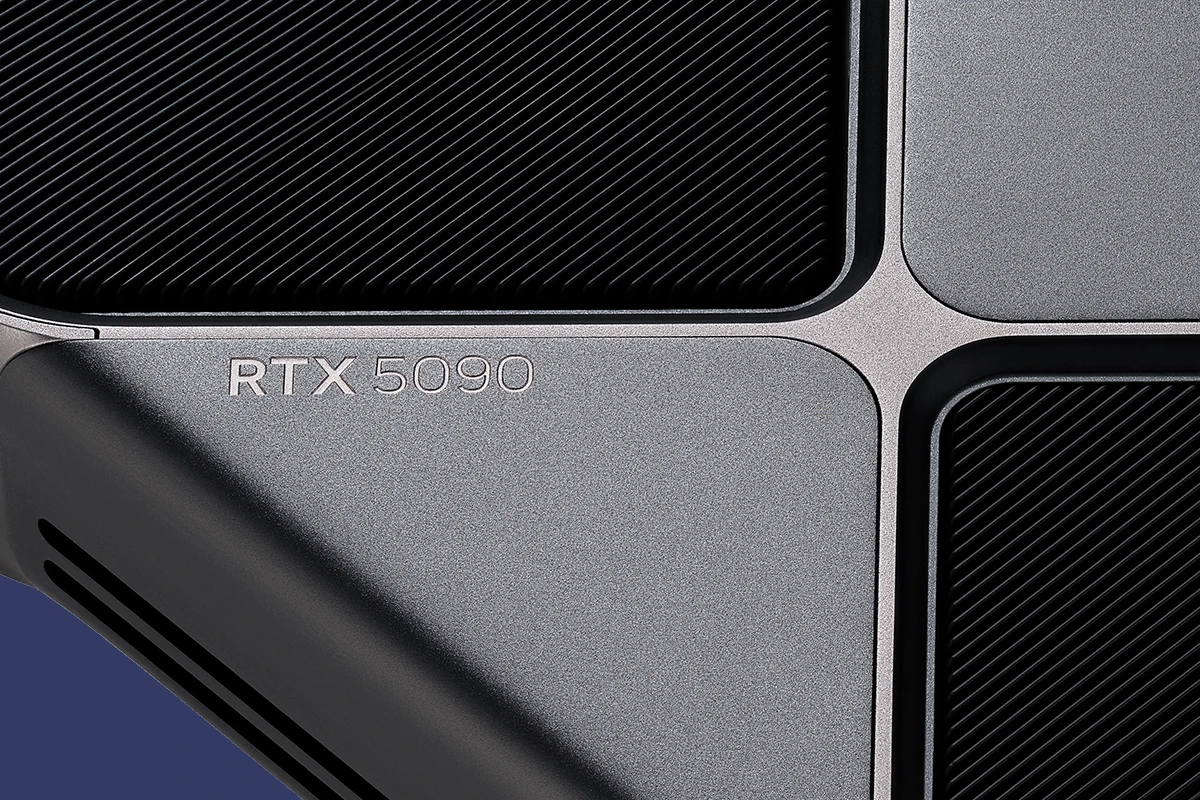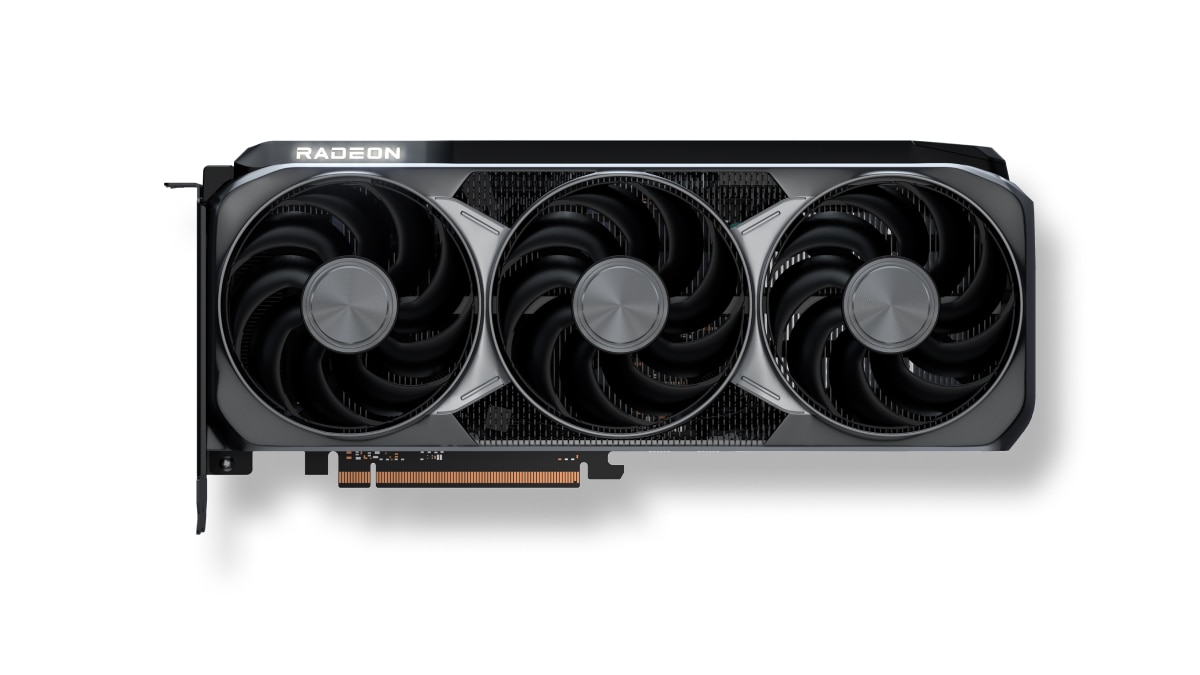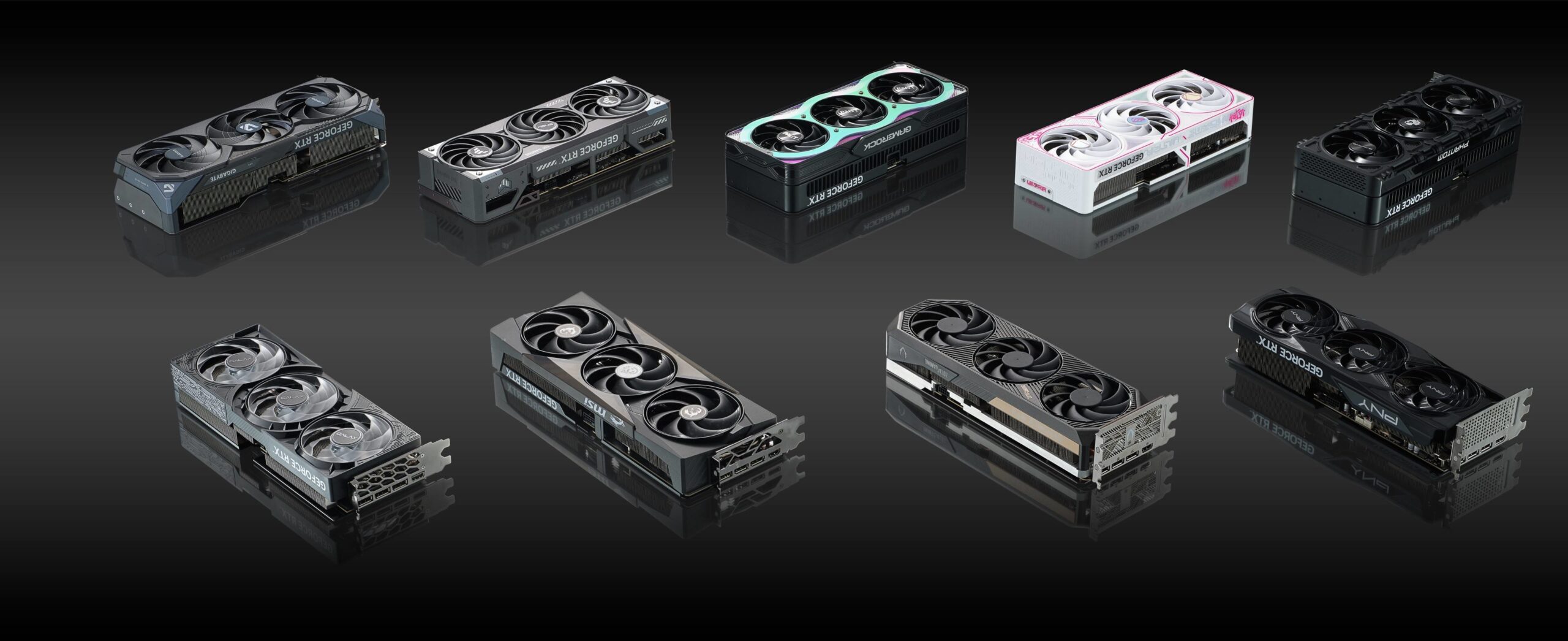Ray tracing is no longer a fringe luxury for ultra-enthusiasts—it’s quickly becoming the visual standard for next-gen gaming and creative workloads. In 2025, the race to dominate real-time ray tracing has accelerated, with NVIDIA leading the charge through its powerful RTX 50 series, AMD countering with its efficient RDNA 4 lineup, and Microsoft pushing the software envelope with DirectX Raytracing 1.2 and neural rendering. Together, these developments signal a transformative year for how games look, feel, and perform.
NVIDIA’s RTX 50 Series & DLSS 4: 8K Gaming in Reach

NVIDIA’s latest GPU lineup built on the Blackwell architecture is headlined by the flagship RTX 5090, which packs fourth-generation RT (Ray Tracing) cores and fifth-gen Tensor Cores optimized for AI-assisted rendering.
The real magic happens with DLSS 4, NVIDIA’s newest upscaling technology that builds on Frame Generation and AI-based temporal reconstruction. Multi-Frame Generation in DLSS 4 doesn’t just interpolate motion—it leverages multiple past and predicted frames, which allows smoother, artifact-free gameplay even at 8K resolutions.
In Assassin’s Creed Shadows, NVIDIA demonstrated that the RTX 5090—paired with DLSS 4—can deliver a stable 60+ FPS at 8K. Without DLSS 4, the same game was barely playable, underscoring just how vital AI-driven enhancements are becoming.
Key Specs of the RTX 5090:
| Feature | Specification |
|---|---|
| Architecture | Blackwell |
| CUDA Cores | 24,576 (rumored) |
| VRAM | 32GB GDDR7 |
| Ray Tracing Cores | 4th Gen |
| DLSS Support | DLSS 4 with Multi-Frame Gen |
| Target Resolution | Up to 8K gaming |
AMD’s RDNA 4: Smarter Ray Tracing for the Midrange Market

AMD isn’t sitting still. The RDNA 4-based Radeon RX 9000 series introduces third-gen ray tracing accelerators that offer up to 2x the throughput of RDNA 3. The RX 9070 and RX 9070 XT, both fitted with 16GB of GDDR6 and PCIe 5.0, target midrange users who want cutting-edge visuals without RTX 5090 price tags.
What makes AMD’s offering stand out is its integration with FidelityFX Super Resolution 4 (FSR 4)—an open-source AI-powered upscaling method. While not quite as refined as DLSS 4, FSR 4 offers impressive gains in supported titles and works across both AMD and NVIDIA GPUs.
AMD’s approach is more democratic: by focusing on performance-per-dollar and keeping hardware accessible, the company is aiming for widespread adoption, particularly among 1440p and 4K gamers.
Microsoft’s DirectX Raytracing 1.2 & Neural Shading
On the software side, Microsoft is pushing innovation through DirectX Raytracing (DXR) 1.2. The update introduces support for:
- Cooperative Ray Tracing: Multiple threads can now manage ray tracing workloads collaboratively, improving efficiency.
- Inline Ray Tracing Enhancements: Allowing developers to control the ray traversal process directly.
- Neural Shading: A revolutionary method that blends traditional rasterization and ray tracing using AI inference for lighting and material calculations.
These advancements streamline GPU workloads and enable real-time path tracing in scenes that would have been computationally prohibitive just a year ago. Unreal Engine 5.4 and Unity 6 are already integrating these features, with Epic Games stating that neural shading will become “the norm” for high-end environments by 2026.
Ray Tracing Goes Mainstream – Even On Consoles
Ray tracing is no longer exclusive to high-end PCs. Nintendo’s Switch 2, launching on June 5, 2025, will include support for ray tracing and DLSS thanks to a custom NVIDIA T239 SoC. This is a major leap for handheld gaming and signals a new baseline for console visuals.
Meanwhile, Sony and Microsoft continue to optimize ray tracing on the PS5 Pro and Xbox Series X|S, with upcoming titles like Stalker 2, Fable, and Avowed utilizing ray-traced global illumination and reflections as core elements of their visual identity.
Even remasters are going all-in. Half-Life 2 RTX, built by the modding team with NVIDIA’s RTX Remix tool, adds full path-traced lighting, DLSS 4, and reworked assets—bringing the 2004 classic into visual parity with modern AAA releases.
Ray tracing in 2025 isn’t just a buzzword—it’s a defining pillar of modern game development. And with GPUs, APIs, and upscaling tech evolving in lockstep, we’re witnessing the next great leap in graphical realism across platforms, price points, and player expectations.
Fundamentals of Ray Tracing
Ray tracing revolutionizes how light behaves in digital environments, creating photorealistic visuals that transform gaming and digital art. This rendering technique works by tracking the path of light rays from the camera to light sources, accurately simulating reflections, shadows, and refractions. Ray tracing delivers significantly more realistic lighting and shadows than traditional rendering methods, generating images that closely resemble real-world visuals.
The technology has advanced dramatically in recent years, moving from specialized professional applications to consumer graphics cards. Modern GPUs from companies like NVIDIA now include dedicated hardware that makes real-time ray tracing possible in games and applications. This advancement represents a fundamental shift in how digital scenes are illuminated and rendered.
While ray tracing creates stunning visual improvements in gaming experiences, it extends far beyond entertainment. The same principles power architectural visualization, product design, and film production. As hardware capabilities continue to grow, ray tracing is becoming increasingly accessible to both developers and consumers.
Ray tracing is a rendering technique that simulates the physical behavior of light to create realistic computer graphics. The method traces the path of light rays as they interact with virtual objects, producing accurate reflections, shadows, and lighting effects.
- Ray tracing simulates realistic lighting by calculating how light rays interact with virtual objects, creating more accurate shadows, reflections, and visual effects.
- Modern graphics cards now include specialized hardware that enables real-time ray tracing in games and professional applications.
- The technology improves visual quality in multiple industries beyond gaming, including architecture, film production, and product design.
Understanding Ray Tracing
Ray tracing works by following light rays as they travel through a scene and interact with objects. Unlike traditional rendering methods, ray tracing calculates how light bounces off surfaces, creating realistic illumination.
The technique simulates three key light transport mechanisms: reflection, refraction, and shadowing. When a ray hits a reflective surface, it bounces off at an angle equal to the incident angle. For transparent objects, refraction occurs as light bends while passing through materials of different densities.
Ray tracing also accounts for light absorption and scattering properties of materials. This allows for accurate rendering of complex visual effects like caustics (focused light patterns) and subsurface scattering in materials like skin or wax.
Ray tracing fundamentals involve algorithms that trace rays from a viewpoint through each pixel in an image plane into a 3D scene.
Comparing Rasterization and Ray Tracing
Rasterization has been the standard rendering technique for real-time applications due to its speed. It works by projecting 3D geometry onto a 2D screen and converting it to pixels.
Ray Tracing simulates actual light physics and produces more realistic results. The key differences include:
| Feature | Rasterization | Ray Tracing |
|---|---|---|
| Lighting accuracy | Approximated | Physically accurate |
| Reflections | Limited, requires tricks | Naturally handled |
| Performance cost | Lower | Higher |
| Real-time capability | Excellent | Improving with hardware advances |
Rasterization uses various tricks to simulate lighting effects that ray tracing handles naturally. However, recent advances in GPU technology have made real-time ray tracing increasingly viable.
Ray Casting and Intersection Calculations
Ray casting forms the foundation of ray tracing. It involves shooting rays from the camera through each pixel and determining what objects they intersect with in the scene.
The process requires solving mathematical equations to find intersections between rays and primitives (basic geometric shapes like triangles or spheres). For each ray, the algorithm calculates:
- If an intersection occurs
- The exact point of intersection
- The surface properties at that point
Efficient intersection testing is crucial for performance. Acceleration structures like Bounding Volume Hierarchies (BVH) organize scene geometry to quickly eliminate objects that couldn’t possibly intersect with a given ray.
For complex scenes with millions of primitives, these acceleration techniques reduce the computational workload from linear to logarithmic complexity, making ray tracing feasible for practical applications.
Ray Tracing in Modern Gaming
Ray tracing technology has revolutionized visual fidelity in games by simulating how light behaves in the real world. This rendering technique creates more realistic shadows, reflections, and lighting effects that transform gaming environments.
Integration into Video Games
Ray tracing first gained mainstream attention when Nvidia introduced their GeForce RTX series in 2018, featuring dedicated RT cores for processing ray tracing calculations. Since then, both AMD and Nvidia have competed to offer better ray tracing performance in their GPUs.
Several popular titles showcase this technology’s capabilities. Minecraft RTX demonstrates dramatic lighting improvements, transforming the blocky world with realistic shadows and global illumination. The difference is striking, with sunlight filtering naturally through trees and water reflecting surroundings.
Cyberpunk 2077 uses ray tracing extensively for reflections in Night City’s puddles, windows, and chrome surfaces. These reflections accurately mirror the neon-soaked urban landscape, adding depth to the game world.
Call of Duty implemented ray-traced shadows that eliminate the harsh, unrealistic edges seen in traditional shadow mapping techniques. This creates more natural-looking environments where light behaves predictably.
Real-Time Ray Tracing Advances
Early ray tracing implementations demanded significant processing power, often forcing gamers to choose between visual quality and smooth performance. Recent technological advances have addressed this challenge.
DLSS (Deep Learning Super Sampling) from Nvidia and FSR (FidelityFX Super Resolution) from AMD use AI upscaling to maintain high framerates while running ray tracing. These technologies render games at lower resolutions then upscale them, reducing performance demands.
Hardware improvements in newer GPUs include:
- More RT cores
- Higher efficiency in ray calculations
- Better denoising algorithms
DirectX Ray Tracing (DXR) has standardized implementation across platforms, making development more straightforward. This API framework allows developers to implement ray tracing without creating custom solutions for different graphics cards.
Impact on Gaming Experience
Ray tracing creates almost lifelike lighting effects that fundamentally change how games look and feel. Accurate shadows and reflections provide spatial awareness cues that flat lighting cannot match.
Horror games benefit particularly from realistic lighting. Darkness feels more threatening when shadows behave naturally, and flashlight beams cast dynamic shadows that respond to movement.
Water and glass surfaces in games like Cyberpunk 2077 and racing simulators now accurately reflect their surroundings. This extends to subtle effects like raindrops on cars reflecting streetlights or puddles mirroring neon signs.
The technology enhances immersion by eliminating the visual shortcuts that previously reminded players they were in a digital environment. Lighting that behaves as expected makes virtual worlds feel more tangible and believable.
Ray tracing also enables new gameplay mechanics, with some titles incorporating mirrors for puzzle-solving or using realistic shadow casting for stealth gameplay that responds naturally to light sources.
Technological Enhancements
Ray tracing technology has undergone significant hardware improvements in recent years, with major GPU manufacturers developing specialized components to handle the intensive computational demands. These advances have made real-time ray tracing increasingly accessible to consumers.
Nvidia RTX and DLSS Technology
Nvidia revolutionized consumer graphics with the introduction of the RTX series in 2018, based on the innovative Turing architecture. These GPUs feature dedicated RT Cores specifically designed to accelerate ray tracing calculations, allowing for real-time ray tracing in games and applications.
The first-generation RTX 2000 series offered a glimpse of ray tracing’s potential, while the RTX 3000 series delivered substantial performance improvements with second-generation RT Cores. The current RTX 4000 series features third-generation RT Cores that provide up to 2-3 times the ray tracing performance of previous generations.
A crucial companion to Nvidia’s ray tracing hardware is DLSS (Deep Learning Super Sampling) technology. DLSS uses AI to upscale images from lower resolutions, compensating for the performance hit that ray tracing typically brings. This clever approach allows games to maintain high frame rates while still benefiting from ray traced effects.
AMD Radeon and Ray Tracing Support
AMD entered the ray tracing arena with the Radeon RX 6000 series GPUs, which introduced their own approach to hardware-accelerated ray tracing. Unlike Nvidia’s dedicated RT Cores, AMD implemented ray accelerators integrated into their compute units.
The RX 6000 series offered competitive ray tracing performance, though generally lagging behind Nvidia’s offerings in raw ray tracing power. AMD’s subsequent RX 7000 series made significant strides in this area, narrowing the gap with Nvidia.
AMD’s answer to DLSS is FSR (FidelityFX Super Resolution), though it uses a different approach that doesn’t rely on specialized AI hardware. This makes FSR compatible with a wider range of GPUs, including those without dedicated ray tracing hardware.
The company continues to improve its ray tracing efficiency through driver updates and architectural refinements, making ray traced graphics more accessible across different price points.
Advancements in GPU Architecture
Modern GPU architectures have been fundamentally reshaped to accommodate ray tracing demands. Both Nvidia and AMD have implemented significant changes to their core designs, moving beyond traditional rasterization-focused approaches.
A key advancement has been the development of specialized silicon dedicated to accelerating the ray tracing process. These hardware components dramatically speed up the complex calculations required for accurate light simulation.
Bandwidth improvements across the memory hierarchy have also been crucial. Ray tracing requires frequent access to large scene data, making cache efficiency and memory speed critical factors in performance.
Future GPU generations are expected to feature even more advanced ray tracing hardware. The trend toward specialized components reflects the industry’s commitment to making cinematic-quality lighting and shadows standard features in real-time graphics.
Practical Applications Beyond Gaming
Ray tracing technology extends far beyond the gaming industry, offering powerful solutions in various professional fields. Its ability to simulate how light interacts with virtual objects makes it invaluable for creating photorealistic images and solving complex visualization challenges.
Ray Tracing in Digital Photography
Ray tracing has revolutionized digital photography by enabling photographers to predict how light will interact with subjects before taking a shot. Software incorporating ray tracing algorithms helps photographers visualize lighting setups without physical equipment.
Modern photo editing applications use ray tracing to create realistic lighting effects and shadows during post-processing. This creates natural-looking images that would be difficult to achieve through traditional editing methods.
Ray tracing also powers computational photography features in smartphones. Portrait mode effects, which create professional-looking depth of field, rely on ray tracing principles to separate subjects from backgrounds and apply appropriate blur.
Advanced 3D imaging in medicine uses ray tracing to generate detailed visualizations. These images help doctors examine internal structures with greater accuracy and plan procedures more effectively.
Application in Film and Realistic Images
The film industry has embraced ray tracing as a cornerstone of visual effects production. VFX artists use ray tracing to create photorealistic CGI elements that seamlessly blend with live-action footage.
Ray tracing enables accurate global illumination in animated films. This technique calculates how light bounces between objects, creating natural ambient lighting effects that were previously impossible to achieve efficiently.
Major studios implement hybrid rendering methods that combine traditional techniques with ray tracing. This approach maximizes visual quality while maintaining reasonable production schedules.
Ray tracing APIs like NVIDIA’s OptiX and Microsoft’s DirectX Raytracing have standardized implementation across different software packages. This compatibility allows artists to work across platforms without sacrificing quality.
The technology also enhances virtual production sets used in shows like “The Mandalorian.” LED walls displaying ray-traced environments provide realistic lighting on actors and physical props during filming.
Future Exploration in Other Fields
Architecture and interior design firms increasingly use ray tracing for client presentations. The technology creates photorealistic previews of buildings and spaces before construction begins, allowing for better client feedback and design refinement.
Ray tracing is transforming product visualization for e-commerce. Companies can now create lifelike digital twins of products with accurate materials, lighting, and reflections that help customers make informed purchases.
In scientific visualization, ray tracing helps researchers understand complex data. Fields like meteorology use it to model how light interacts with atmospheric particles, improving weather prediction models.
Automotive design benefits from ray tracing through real-time visualization of new vehicle concepts. Designers can immediately see how different materials and lighting conditions affect their designs.
As AI integration advances, ray tracing will become more accessible and efficient. Machine learning algorithms are already being developed to reduce the computational cost of ray tracing while maintaining visual quality.
Visual and Performance Impact
Ray tracing delivers stunning visual improvements while requiring significant computational resources. The technology transforms lighting, reflections, and shadows in games but often demands hardware compromises to maintain playable frame rates.
Improving Visual Fidelity
Ray tracing dramatically enhances visual realism through more accurate light simulation. Games with ray tracing feature true-to-life reflections on surfaces like water, glass, and polished metal that accurately mirror the surrounding environment. This represents a major upgrade from traditional screen space reflections that can only reflect what’s visible on screen.
Shadows become more natural with soft edges that change based on light source distance and size. This eliminates the harsh, unrealistic shadow lines seen in older rendering techniques. Global illumination benefits enormously, as light bounces realistically between surfaces, creating subtle color bleeding effects and more accurate ambient lighting.
Ray-traced effects also improve the overall atmosphere through enhanced brightness gradients and more complex shading. Recent testing across 36 games shows that while visual improvements vary by title, games with wet surfaces, nighttime settings, or reflective environments benefit most.
Optimizing Frame Rate and Resolution
The primary challenge with ray tracing is its substantial performance impact. When enabled, games often experience a 30-50% drop in frame rate, making optimization crucial for playable experiences.
Modern GPUs offer several technologies to mitigate these performance costs:
- DLSS (NVIDIA): Uses AI upscaling to render at lower resolutions before enhancing image quality
- FSR (AMD): Provides resolution upscaling without requiring specialized hardware
- XeSS (Intel): Offers temporal upscaling to boost performance
Denoising algorithms play a critical role by reducing the grainy appearance that can occur with limited ray samples. Without effective denoising, developers would need to cast more rays, further hurting performance.
Resolution scaling offers another effective compromise, allowing games to render ray-traced effects at lower resolutions (like 1080p) while displaying the final image at higher resolutions (like 4K).
Balancing Quality and Performance
Finding the optimal ray tracing configuration requires understanding which effects deliver the most visual impact for their performance cost. Not all ray-traced effects are created equal – reflections typically provide the most noticeable visual improvements, while ray-traced ambient occlusion often yields subtler results.
Most games offer granular ray tracing options:
- Ray-traced reflections: Highest visual impact but costly
- Ray-traced shadows: Moderate visual improvement with medium performance hit
- Ray-traced global illumination: Significant visual enhancement but very demanding
For players with mid-range hardware, selective enabling of ray-traced features often provides the best experience. Turning on reflections while leaving other ray tracing features disabled can maintain acceptable frame rates.
Future hardware improvements will gradually reduce these performance tradeoffs. Current implementation quality varies significantly between games, with some titles showing dramatic visual improvements and others offering minimal enhancements that may not justify the performance sacrifice.
Challenges and Limitations
Despite its impressive capabilities, ray tracing faces several significant hurdles that impact its widespread adoption and practical implementation. These challenges range from the raw computational power required to the cost considerations and accessibility issues.
Computational Complexity
Ray tracing demands enormous computational resources due to its physics-based approach to light simulation. Each ray must be calculated and tracked as it bounces through a scene, creating a processing bottleneck that even modern CPUs struggle with.
When implementing real-time ray tracing, developers face significant performance issues as the algorithm is inherently more calculation-intensive than traditional rendering methods. A single frame might require millions or billions of light ray calculations.
Hardware acceleration has become essential, with specialized RT cores on modern GPUs handling these complex calculations. Despite these advances, complex scenes with global illumination and multiple light bounces still cause frame rates to drop considerably.
Path tracing, an extension of ray tracing that simulates indirect lighting more accurately, compounds these issues by requiring even more computational power to achieve noise-free results.
Cost vs. Benefit Analysis
The benefits of ray tracing must be weighed against its considerable costs:
Hardware Investment:
- High-end GPU with dedicated RT cores
- Sufficient system RAM (16GB minimum recommended)
- Fast CPU for scene preparation
Performance Trade-offs:
- Lower frame rates
- Higher power consumption
- Increased thermal output
Many developers implement hybrid approaches that use ray tracing selectively for specific effects such as shadows, reflections, and ambient occlusion while relying on traditional rasterization for other elements. This compromise helps balance visual quality with performance.
For some applications, the visual improvements may not justify the performance hit. Simple scenes or fast-paced games often prioritize frame rate over the subtle lighting improvements ray tracing provides.
Ray Tracing Accessibility
Ray tracing technology remains inaccessible to many users due to hardware limitations. Only the latest generation of graphics cards fully support hardware-accelerated ray tracing, creating a significant barrier to entry.
VR applications face particular challenges implementing ray tracing due to the dual rendering requirement and already high performance demands. The technology requires careful optimization strategies including:
- Reduced draw calls
- Instanced meshes
- Minimizing active lights
- Lower ray bounce limits
Software compatibility also presents challenges. Developers must choose between different APIs and frameworks that support ray tracing, such as NVIDIA RTX, DirectX Raytracing (DXR), or Vulkan Ray Tracing.
Cross-platform development becomes more complex when targeting both ray tracing-capable and non-capable hardware, requiring fallback rendering paths and scalable solutions to ensure wider market reach.
Industry Adoption and Trends
Ray tracing technology has seen remarkable growth across multiple sectors, with the gaming industry leading adoption. The market value reached $410 million in 2025, with projections showing a CAGR of 34.6% through 2033.
Major Games and Engines Supporting Ray Tracing
The gaming industry has embraced ray tracing as a standard feature in high-end titles. Unreal Engine stands at the forefront, having fully integrated real-time ray tracing capabilities that simulate realistic light behavior in virtual environments.
Popular titles implementing ray tracing include:
- Cyberpunk 2077 – Uses RTX for realistic reflections and shadows
- Minecraft RTX – Complete visual overhaul with path tracing
- Call of Duty: Modern Warfare – Features ray-traced shadows
- Control – Widely praised for ray-traced reflections and transparent surfaces
Unity Engine has also incorporated ray tracing features, though with different implementation approaches than Unreal. These engines provide developers with tools to create more photorealistic rendering while balancing performance costs.
Market Penetration and Consumer Adoption
Consumer adoption of ray tracing depends heavily on hardware availability. Since NVIDIA launched RTX technology, the market has grown steadily despite initial hardware limitations.
Key adoption factors include:
- Hardware costs: High-end GPUs required for optimal performance
- Game support: Growing library of compatible titles
- Performance trade-offs: FPS impact versus visual improvements
A significant shift occurred when console manufacturers incorporated ray tracing capabilities in the PS5 and Xbox Series X/S, bringing this technology to a wider audience. The technology has also gained traction in product advertising and architecture, where visual realism is paramount.
Influence on Hardware Development
Ray tracing has fundamentally changed GPU development priorities. NVIDIA’s RTX series represented the first major consumer hardware specifically designed with dedicated ray tracing cores.
The hardware response includes:
- Dedicated RT cores – Specialized processing units for ray calculations
- Tensor cores – AI acceleration to enable DLSS and similar upscaling technologies
- Competition growth – AMD’s RDNA architecture and Intel’s entry into discrete GPUs
Each hardware generation has focused on improving ray tracing performance while reducing its computational cost. AI acceleration has become essential, with technologies like NVIDIA’s DLSS and AMD’s FSR helping to offset performance impacts of ray tracing processing.
These developments suggest ray tracing will become standard in rendering pipelines as hardware continues to evolve, with material properties and reflective surfaces becoming increasingly realistic.
Current State and Future of Ray Tracing
Ray tracing technology has evolved significantly in recent years, transforming from a technique used primarily in pre-rendered content to one that is increasingly viable in real-time applications. The current implementations blend traditional rasterization with ray tracing elements, while future developments promise even greater realism across multiple platforms and industries.
Reflections on the Current Ecosystem
The ray tracing landscape in 2025 features a hybrid rendering approach that combines traditional rasterization with ray tracing techniques. Major gaming engines like Unreal Engine and Unity have integrated ray tracing features to enhance visual fidelity while maintaining performance.
NVIDIA continues to lead hardware support through their RTX series GPUs, which offer dedicated RT cores for accelerated ray tracing calculations. AMD and Intel have also entered the competition with their own ray tracing hardware solutions.
Games like Battlefield V and Cyberpunk 2077 showcase the technology’s current capabilities, implementing reflections, shadows, and global illumination with varying levels of ray tracing intensity. Some developers opt for selective implementation, applying ray tracing only to specific elements like reflective surfaces or water.
Mobile platforms have also joined the ray tracing revolution, with the iPhone 15 Pro being among the first smartphones to support limited ray tracing features.
Predictions and Future Developments
The future of ray tracing points toward full real-time implementation as hardware continues to advance. Next-generation GPUs will likely feature significantly improved ray tracing performance, potentially making fully ray-traced games at high resolutions and framerates possible.
AI integration represents another frontier, with machine learning algorithms helping to reduce the computational cost through intelligent denoising and upscaling techniques. NVIDIA’s DLSS technology already demonstrates this synergy between AI and ray tracing.
Hardware manufacturers are developing specialized ray tracing units that could eventually replace traditional graphics pipelines entirely. This shift might lead to new game engine architectures built from the ground up for ray tracing.
Path tracing, a more comprehensive form of ray tracing that simulates many light bounces, may become viable for real-time applications in the next 3-5 years.
Expanding Realism in Various Mediums
Ray tracing’s impact extends well beyond gaming. Architecture and interior design firms increasingly utilize real-time ray tracing for client presentations, allowing immediate visualization of lighting changes and material selections.
Film production has embraced real-time ray tracing for previsualization and virtual production, with LED wall technology using ray-traced backgrounds for in-camera effects. This reduces post-production costs and provides actors with realistic visual references.
Virtual reality applications benefit particularly from ray tracing’s accurate lighting and reflections, which enhance immersion by matching users’ expectations of how light behaves. Accurate scattering effects for materials like skin, fog, and subsurface materials are becoming more computationally feasible.
Automotive design and virtual product showcases use ray tracing to create photorealistic visualizations that accurately represent materials like car paint, chrome, and various finishes under different lighting conditions.







